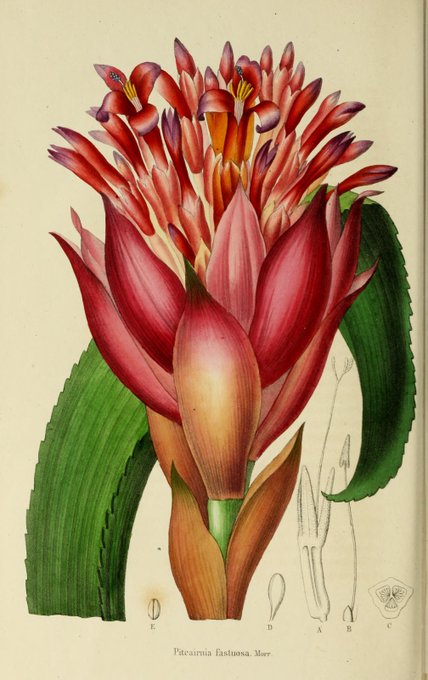#BotanicMonday: Flaming torch bromeliads (Billbergia pyramidalis) are terrestrial and epiphytic. #SciArt from Annales de la Société Royale d'Agriculture et de Botanique de Gand, T.3 (1847), edited by Charles Morren, via @HarvardLibrary Botany Libraries: https://t.co/mRZv5VeD3v
#MycologyMonday: "Histoire des champignons comestibles et vénéneux" details the characteristics of a variety of edible and poisonous mushrooms. 🍄
Find the 2nd ed. (1841) in #BHLib via @uofglibrary @internetarchive ➡️ https://t.co/dKJ6djHIod
#BotanicMonday: a cultivar of Sturt's Desert Pea (Swainsona formosa), one of Australia's most recognizable #wildflowers. #SciArt by P. Stroobant for "L'Illustration Horticole", Vol. 12 (1865), contributed in #BHLib by the Raven Library of @mobotgarden ➡️ https://t.co/qbuvycC92J
Elinor Frances Vallentin collected hundreds of plant specimens from the Falkland Islands. She illustrated many of these in her 1921 work on Falkland Islands botany, which is freely available online in #BHLib via @FieldMuseum ➡️ https://t.co/N1E0DPjDtj
#HerNaturalHistory
English naturalist William Turton's passion was conchology. He published several illustrated #shell books, including "A Conchological Dictionary of the British Islands" (1819). The work is free online thanks to @museumsvictoria @bhl_au ➡️ https://t.co/DHC4PvADww
#MolluskMonday
George Ernest Shelley's "The Birds of Africa" (1896-1912) reviews more than 2,500 birds. The 57 hand-colored lithographic plates are after #SciArt by Henrik Grönvold. All 5 volumes are freely available online in #BHLib via @SILibraries ➡️ https://t.co/3TwX7vpDOp
#Feathursday
"Canadian Wild Flowers" (1868) was one of the 1st serious botanical works in Canada. It was authored & illustrated by women — Catharine Parr Traill & Agnes Fitzgibbon Chamberlin. It is freely available online via @MuseumofNature ➡️ https://t.co/PmwELa51Bc
#HerNaturalHistory
Anne Pratt (1806-1893) was one of the most popular artists and writers of the “Golden Age of botanical art”. Producing 20 publications, she helped create interest in flower study in the general public. Learn more ➡️ https://t.co/sxUI5xB6vf
#HerNaturalHistory
Carnivorous plants obtain nutrients from animals or protozoans, which they trap and digest. #SciArt of "insektenfressnde pflanzen" ("insectivorous plants") from "Meyers Konversations-Lexikon", v. 8 (1890, 4th ed.). In #BHLib from @uoftlibraries ➡️ https://t.co/KzkHjy2TbD
We're captivated by the wildlife scenes in "African scenery and animals" (1804-05), featuring hand-colored aquatints after art by Samuel Daniell. So, we're sharing these scenes for #WorldWildlifeDay. Find them in #BHLib via @SILibraries ➡️ https://t.co/OF9RSk2Tks


























